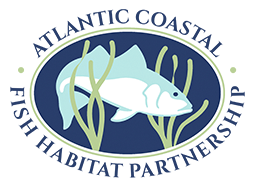|
December 22, 2014 |
|
|
Oyster reef restoration in Great Bay Estuary, New Hampshire. Photo courtesy of The Nature Conservancy, NH. |
|
|
|
This has been an exciting year for the Atlantic Coastal Fish Habitat Partnership (ACFHP), thanks to the cooperation among our federal, state, conservation organizations, and local partners. Over the past year the Partnership has worked hard to continue building our project funding programs and strengthen our collaborative efforts with other entities. The Partnership welcomed the International Federation of Fly Fishers (IFFF, www.fedflyfishers.org) as its newest member, and Lisa Havel as the new Coordinator following Emily Greene’s departure after 6 productive years. To honor Emily’s dedication to improving fish habitat along the Atlantic Coast, ACFHP honored her with the Melissa Laser Award at the 7th National Summit on Coastal and Estuarine Restoration in National Harbor, Maryland in November.
Project funding ACFHP has partnered with the U.S. Fish and Wildlife Service (USFWS) for the fifth consecutive year to fund two new on-the-ground restoration projects in 2014. The first focuses on Eastern oyster (Crassostrea virginica) reef and salt marsh habitat (Spartina alterniflora) restoration along 200 feet of estuarine shoreline in Stump Sound, Holly Ridge, North Carolina, and is led by the North Carolina Coastal Federation. The second, led by the New Hampshire Chapter of The Nature Conservancy, will restore two acres of oyster (C. virginica spat on Spisula solidissima shells) reef in Great Bay Estuary, Rockingham County, New Hampshire. Both projects will increase the extent of living shoreline, which in turn will augment resiliency to climate change-induced sea level rise. For more information on these and other ACFHP-USFWS funded projects, please visit here.
ACFHP expanded the implementation of conservation moorings to Jamestown, Rhode Island this year thanks to funding provided by the National Oceanic and Atmospheric Administration (NOAA) and support from the Rhode Island Division of Fish and Wildlife, Town of Jamestown Conservation Commission, Clarks Boat Yard, Conanicut Marine Services Inc., and Rhode Island Marine Trades Association. Conservation moorings use a buoyant bungee-like cord to minimize contact with the seafloor. This eliminates “chain sweeping” and subsequent damage to submerged aquatic vegetation that occurs around traditional mooring systems. Area mapping and pre-monitoring are underway, and the moorings will be fitted in place next spring. To learn more about conservation moorings, please read about our eelgrass restoration efforts.
Collaboration Opportunities For the past year ACFHP has partnered with The Nature Conservancy and other partners to prioritize, plan, and strategize river herring needs in the southern New England, Mid-Atlantic, and Southeast regions of the United States. This work is funded by the National Fish and Wildlife Foundation River Herring Initiative. The project involves collaboration with state and federal agencies and non-governmental organizations via in-person workshops and webinars. This project will result in multiple reports on river herring habitat needs for each geographic focal area, as well as advance the cooperation among stakeholders in each region, and aid ACFHP in prioritizing river herring restoration needs for future USFWS project funding. Check back early next year for an update on our findings!
ACFHP has continued its Whitewater to Bluewater project this year with its Fish Habitat Partnership neighbors, the Southeast Aquatic Resources Partnership (SARP) and the Eastern Brook Trout Joint Venture (EBTJV). This initiative promotes a collaborative approach to implementing their respective goals and the National Fish Habitat Action Plan. Currently, we are working on a Fish Passage Barrier Removal Fact Sheet that allows for conservation groups and agencies to easily modify the content in order to reach target audiences. The fact sheet will be available in the spring of 2015.
Significant progress has been made in the development of a Decision Support Tool to Assess Aquatic Habitats & Threats in North Atlantic Watersheds & Estuaries. ACFHP and its partners are working with Downstream Strategies, LLC to compile and analyze the threats to inland, estuarine, and coastal aquatic species across the Northeast Atlantic. These data are then used to model species distributions, which will provide information to produce both distribution maps and a multi-criteria decision support tool for resource managers. This work is funded by the North Atlantic Landscape Conservation Cooperative. Eastern brook trout and winter flounder models are close to completion, and data is currently being compiled to begin analyses on river herring. For more information on this project and the North Atlantic Landscape Conservation Cooperative, please visit their website .
In early November, ACFHP attended the 7th National Summit on Coastal and Estuarine Restoration at the Gaylord National Convention Center in National Harbor, Maryland. ACFHP not only had an exhibit in the Exposition Hall that reached over 1000 participants, but presented at the conference during the Coastal Fish Habitat Partnership session. This session included presentations from Coastal Fish Habitat Partnerships spanning the national coastline: ACFHP (Atlantic region), SARP (Gulf coast), and Western Native Trout Initiative (Pacific region), as well as a panel discussion focused on aiding Coastal Fish Habitat Partnership coordination efforts. For more information on the summit, please visit the Restore America’s Estuaries website.
We are grateful for your constant support of fish habitat conservation and restoration efforts here at ACFHP, and wish a very happy holiday season from everyone here at the Partnership!! |

